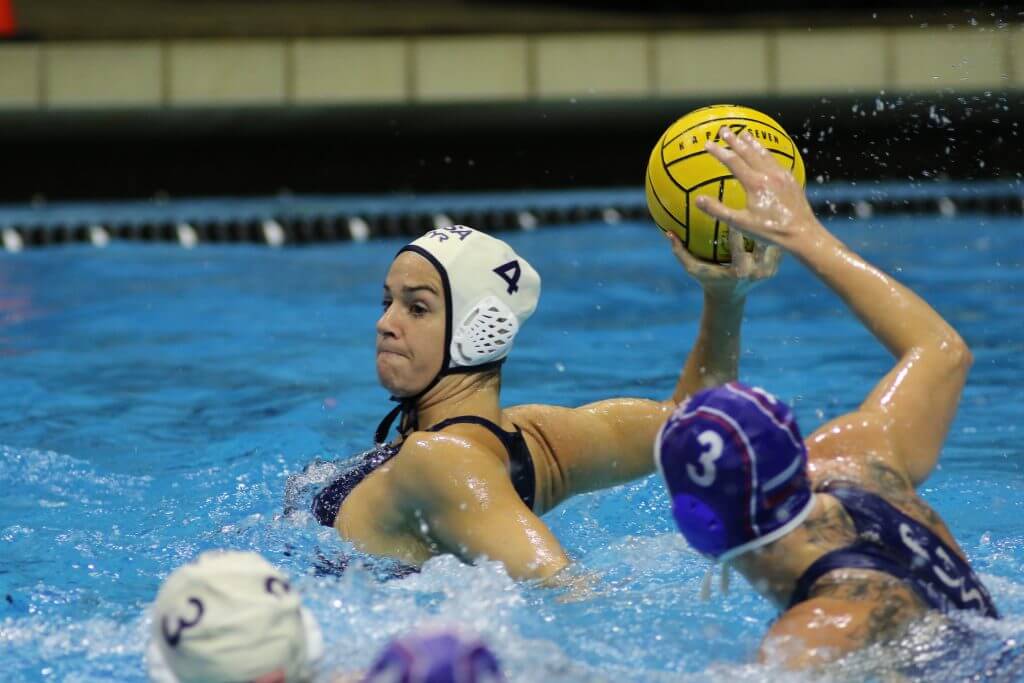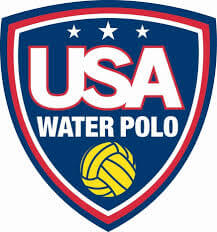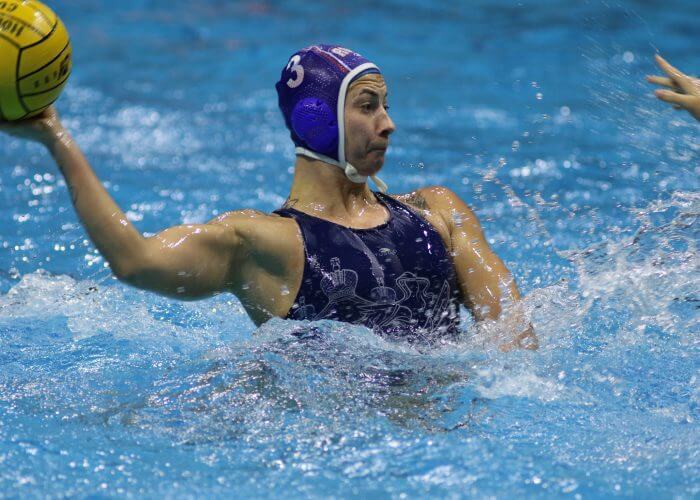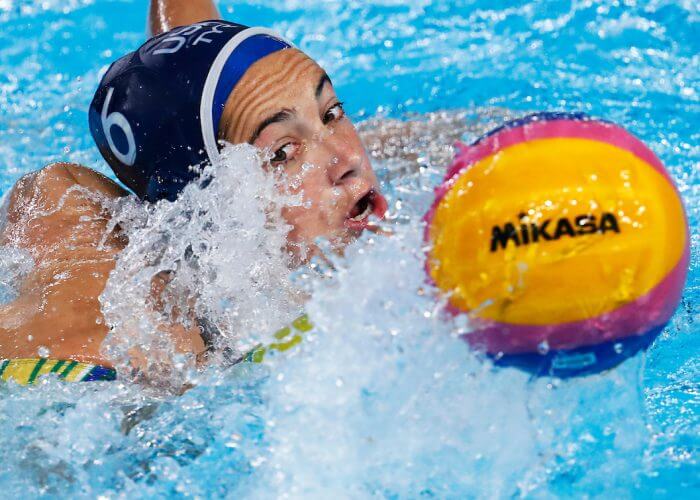Anywhere, Anytime: The U.S. Women Beat Russia In Opener of USA Water Polo Holiday Cup

PRINCETON, NJ. As teams from the world over warmed up in Princeton’s DeNunzio Pool on Monday night, in the stands there was a relaxed, almost casual atmosphere prior to play between some of the world’s best women’s water polo players.
 The big barn of an aquatics facility — an East Coast hub for age group and collegiate play — was populated with local polo fans milling about and exchanging pleasantries, as if old friends with a chance encounter at a familiar place.
The big barn of an aquatics facility — an East Coast hub for age group and collegiate play — was populated with local polo fans milling about and exchanging pleasantries, as if old friends with a chance encounter at a familiar place.
But there was nothing like pleasantries being exchanged in the water, especially when the American and Russian teams scrummed in the second of two games on opening night of the 2019 USA Water Polo Holiday Cup.
Team USA gutted out a physical 9-5 win over Russia, after the Netherlands and Canada open with a match competitive for almost three quarters before the Dutch women finished with a seven-goal flourish to take a 17-8 decision. With their win the Americans extended their win streak to sixty-four; they last lost a match in April, 2018.
Tuesday’s matches: Russia vs. Italy and U.S. vs. Netherlands; both can be streamed via Facebook here.
Brilliant players in a distinctive indoor venue
This year’s Holiday Cup represents the melding of Team USA desires for recognition on the coast opposite the sport’s home in America with Canadian, Dutch, Italian and Russian hopes to compete against the world’s top squad wherever possible — and ideally in Tokyo next summer. The U.S. has already punched its ticket to the 2020 Games, and as two-time defending Olympic champions riding a gaudy win streak — including the victory Monday night — the rest of the world is chasing them. But outside of this country’s small, tightly-knit community of polo enthusiasts primarily located in California’s Bay Area and Socal regions, not many folks know about Team USA’s other-worldly success.
[Want to See the World’s Greatest Water Polo Players? They’re in New Jersey This Week]
Canada, who last weekend hosted these teams in its own invitational in Montreal, is striving to improve in advance of the program’s first Olympic appearance since the 2004 Games in Athens. The other three teams in attendance this week in The Garden State have a decidedly more utilitarian goal: prepare for the European qualifications for the 2020 Games, a tournament that to be held at the end of next month in Budapest, Hungary.

Russia’s Ekaterina Prokofyeva is one of the games’ best players. Photo Courtesy: Sherie Key/USAWP
That there was a good crowd at the pool is a credit to USA Water Polo. The governing body responsible he for the sport in America worked to get local youth clubs involved. As they and their parents chatted in between action, the women water warriors practiced their craft, with a number of exceptional players in De Nunzio, even if this first day’s action felt like an exhibition.
Sabrina van der Sloot, the Dutch captain who is numbered as one of the world’s best players, did not flash her deadly shot, scoring only twice in limited action. But her passes were so accurate and her command in the pool distinctive; given the low stakes of the competition her talent radiated, perhaps eagerly absorbed by a bevy of local age-group players dotting the stands.
A couple of foreign players from American colleges populated the Dutch and Canadian rosters. For Head Coach Arno Havenga, his lanky 6-2 striker Maud Megens is quite familiar to fans of the USC women’s squad, where she has starred the past three years. Kitty Lynn Joustra, a center for Cal, was also in the water, while Arizona State’s Maud Koopman was on the Dutch attack.
The decided star of the game was Ilse Koolhaus, who struck early for four goals then sent much of the second half on the bench as her teammates turned a two-goal lead midway through the third period into a blow-out win, reeling off seven goals to close out the Canadians.
There were numerous familiar faces on Canada’s roster. Pacific’s Kyra Christmas tallied a hat-trick to lead her teammates, but could not stem the barrage of Dutch goals over the match’s final two periods. Emma Wright, Joustra’s teammate at Cal, and Monika Eggens — a former star for Hawai’i — registered one goal. Rounding out the Canadian attack was Shae Fournier, a one-time Hoosier like Canadian goalie Jessica Gaudrealt, was joined by Kindred Paul — formerly of Cal; Elyse Lemay-Lavoie of Hawai’i and former USC Trojan Hayley McKelvey.
Christmas was the lone bright spot in what was otherwise a disappointing match for the Canadians. Even though his team has qualified, Head Coach David Paradelo has to know that breaking into top five in the world — a goal professed last summer at the 2019 Pan American Games — is a tall order for a team competing in its first Olympics in almost two decades.
Two foes, two styles, same result
The Russians do not have any players matriculating at American schools, and they were not at all intimidated by a U.S. squad that had beaten them 18-13 in Montreal. On the game’s opening possession, Russian center Anna Timofeeva gave Makenzie Fischer a shot to the chin, causing the American defender’s head to snap back — and resulting in an offensive foul. This established a level of physical play that could never be termed “friendly;” the two teams wrestled and pushed and kicked, not giving any quarter.
Given their size, it might be assumed that the Russians would get the better of most encounters. But this underscores why the Americans are so good —and why they continue to extend a win streak that is now 20 months long. In a finesse game, Krikorian’s players are incredibly skillful and can beat teams with deft passing, superb shooting and overwhelming counter attacks, much as they did in the previous match between the two teams. But in the match the Russians chose to play on Monday — low scoring with every drive and shot contested — the U.S. is also entirely comfortable.
Maggie Steffens, whose toned physique is perfectly suited for a sport that demands speed, endurance and brute physical strength, sped around and through various Russian road blocks, not scoring but making opportunities for her teammates. The American captain made an inside pass to Makenzie Fischer to draw a crucial five-meter penalty in the third period that extended a U.S. advantage to three.

Team USA’s Maggie Steffens. Photo Courtesy: Marcos Brindicci
Leading the U.S. attack with two goals were Maddie Musselman— Head Coach Adam KriKorian’s designated sharpshooter who since her debut at the 2016 Olympics has become one of the world’s great scorers — and Kiley Neushul.
Melissa Seidemann, who like Steffens is chasing a possible third-straight Olympic gold, had a brilliant goal in front of the Russian cage, fighting off two defenders and beating goalie Anna Ustiukhina.
But the brightest star in a constellation of American brilliance was their goalie. Ashleigh Johnson stared at De Nunzio for four years, leading the Tigers to two NCAA tournaments and earning the 2017 Cutino Award — the first-ever player from the East to be honored as the country’s top female collegiate player. The 6-1 Johnson is so active in front of her cage, it might as well be that she is a goalie on turf, moving, feinting, leaping, preventing.
Time and again the Russians launched shots at or around her and her cage. The first half ended with the U.S. ahead 4-1 thanks to their goalie’s brilliance. Johnson proved mortal in the third and fourth periods, giving up goals to Elvina Karimova, Maria Borisova, Olga Gorbunova and Evgeniia Soboleva. But, with the lead narrowed to two, and their opponents looking to cut it in half, Kiley Neushul converted a power play, Musselman scored and Neushul scored again to keep the U.S. lead safe — and their awesome winning streak alive for yet another day.




